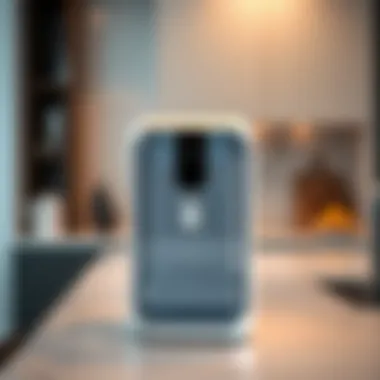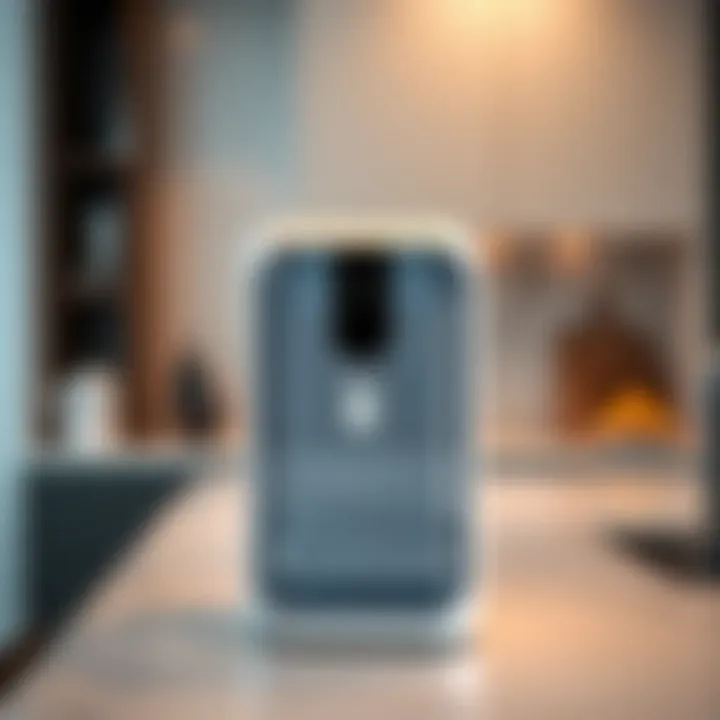Your Complete Guide to Countertop Water Filtration


Intro
In a world that often seems to be buzzing with choices, countertop water filtration dispensers stand out as a beacon of practicality and health. These devices have gained traction among households for their capability to serve cleaner, safer, and more enjoyable drinking water right from your kitchen counter. But what exactly makes them essential?
With the increasing concerns about water quality, particularly contaminants that can infiltrate our drinking supply, many families are investing in these dispensers. The rising popularity isn’t just about convenience; it’s also about fostering a healthier lifestyle and taking strides towards environmental sustainability.
Beyond the basics of purification, this guide will navigate through various filtration technologies that are the backbone of these dispensers. It goes without saying; choosing the right system can feel a bit daunting, especially with the myriad of options available on the market. That’s why we've dug deep to provide clarity, offering sound advice on product comparisons, maintenance, and key consumer considerations.
Let’s embark on this exploration, equipping you with the knowledge necessary to select the ideal filtration system that aligns with your family’s needs while also enhancing your kitchen's aesthetic. After all, a clean glass of water is just the tip of the iceberg; the benefits that flow from it can ripple throughout your entire home.
Prelude to Countertop Water Filtration Dispensers
In a world filled with pollutants, contaminants, and the occasional mystery taste in tap water, countertop water filtration dispensers have carved out their niche as vital appliances in modern households. For many, clean drinking water is more important than ever. The notion of purifying water at home is not just a convenience; it touches on health, sustainability, and simple peace of mind.
Definition and Purpose
A countertop water filtration dispenser is a device designed to improve the quality of your water supply by filtering out impurities, chemicals, and unpleasant tastes. Unlike traditional methods, these dispensers are easy to set up and don’t require permanent installation. The primary purpose is to ensure that every glass of water drawn is as clean and refreshing as nature intended. In practical terms, it often means removing chlorine, heavy metals, and possibly bacteria from your drinking water, making it safer and more enjoyable.
The versatility of these dispensers makes them an attractive option for households of all sizes. Whether you're a busy parent looking to provide the best for your children or a retiree wanting to enjoy life without worrying about water quality, these dispensers cater to a broad audience. Their ability to fit comfortably on a kitchen countertop adds to their appeal, allowing them to be both functional and accessible.
Historical Context
When we rewind the clock, water filtration has been around in various forms for centuries. Ancient methods involved charcoal and sand, techniques that are still fundamental in modern filtration systems. With the rise of industrialization, the compounds found in water sources have become increasingly sophisticated, leading to a growing public demand for more effective filtration methods.
Countertop devices began gaining traction in the late 20th century as concerns about water quality surfaced—not just from pollution but also from the chemicals used in municipal water treatment. The friendly neighborhood water filter, perhaps, was born from the recognition that tap water, while convenient, might not always be safe. Thus, the countertop water filtration dispenser was born, providing both a solution and a response to a shifting societal perspective on health and wellness.
The evolution continued into the 21st century with rapid advancements in technology. Today, these dispensers harness sophisticated filtration technologies like activated carbon and reverse osmosis, which may have seemed like science fiction a few decades ago. As individuals and families become increasingly informed about water quality, the essential role of countertop water filtration dispensers becomes undeniable.
Importance of Clean Water
Water is essential, and its quality plays a critical role in our daily lives. Clean water isn't just about taste; it goes beyond that. It's closely linked to health, wellbeing, and environmental sustainability. Having a decent water supply that is free from harmful contaminants can dramatically impact one's life. In this part of the article, we will explore two key aspects of why clean water is essential: the health benefits and the environmental considerations that come into play when discussing countertop water filtration dispensers.
Health Benefits
The importance of clean water for health cannot be overstated. In many households, tap water might carry traces of impurities – whether it's chlorine, lead, or other questionable contents. Using a countertop water filtration dispenser can significantly alleviate these concerns.
- Reduction of Harmful Chemicals: These dispensers are equipped with advanced filtration systems that significantly reduce the presence of toxic substances in drinking water. This means less exposure to harmful agents that could lead to long-term health issues.
- Hydration and Wellbeing: Clean drinking water is vital for maintaining hydration. Adding a countertop filter can enhance the flavor and quality of water, making it more appealing to drink, which can promote better hydration habits among family members.
- Enhanced Nutrients Absorption: When you're consuming cleaner water, your body tends to absorb nutrients better. An adequate level of hydration aids digestion and supports metabolic processes, making you feel more energetic and balanced.
Moreover, studies indicate a direct link between clean water access and reduced risk of waterborne diseases. Filters can serve as a first line of defense against these illnesses, particularly for younger children and elderly family members, who might be more susceptible to infections.
Environmental Considerations
Beyond personal health, the ripple effect of using filtration dispensers extends into environmental considerations. Here's a closer look at the factors that matter:
- Reduction of Plastic Waste: Every year, billions of plastic bottles end up in landfills. By opting for countertop filtration systems, households can drastically cut down their reliance on single-use plastic bottles, thus encouraging a more sustainable lifestyle.
- Energy Conservation: Mineral-rich tap water filtered through countertop systems uses significantly less energy than the process of bottling and transporting water. Clean water through local filtration reduces the carbon footprint associated with these activities.
- Promoting Local Water Sources: When people use countertop water filtration dispensers, they begin to trust their local water systems more, thereby boosting community investment in public water quality. Good local water sources lead to less strain on distant ecosystems.
"Every drop counts, and clean water is not only a right but a responsibility we bear towards our planet."
Understanding Filtration Technologies
When it comes to countertop water filtration dispensers, grasping the various filtration technologies is fundamental to making an informed choice. Each method serves a unique purpose, catering to different contaminants and user preferences. With so much riding on clean water—our health, convenience, and the overall state of our environment—understanding how these systems work can be empowering. This section will shed light on three primary filtration technologies: activated carbon filters, reverse osmosis systems, and ultraviolet purification.
Activated Carbon Filters
Activated carbon filters are often heralded as the stalwarts of home water filtration. These filters utilize carbon that has been treated to create a vast network of tiny pores, increasing its surface area to absorb impurities. Think of it as a sponge that soaks up pollutants like a sponge absorbing water, trapping elements such as chlorine, sediment, and some volatile organic compounds.
When using activated carbon, one key benefit is its effectiveness against bad tastes and odors, making the water more palatable. However, it does have some limitations; for example, it might not effectively filter out heavy metals or microorganisms. Homeowners often appreciate the practicality of these filters since they require minimal energy and upkeep, making them a popular choice.
"Activated carbon isn't just a filter; it's a premium upgrade for your water experience."
Reverse Osmosis Systems
Delving deeper into filtration technologies, we encounter reverse osmosis—a method that has gained traction for its thorough approach. Essentially, reverse osmosis (RO) uses a semipermeable membrane to remove particles from water. The process pushes water through this membrane, leaving contaminants behind. This technology is particularly adept at filtering out a wide range of impurities, including heavy metals and even some microorganisms.


What sets reverse osmosis apart is its ability to purify water significantly, making it a solid choice for households that prioritize purity. However, this level of filtration comes with its own set of considerations. RO systems can waste a fair amount of water in the filtration process, and they also take time to filter larger quantities. Moreover, some minerals that are beneficial to health may also be stripped away. Homeowners need to weigh the pros and cons carefully.
Ultraviolet Purification
Lastly, we have ultraviolet (UV) purification—a technology that brings a unique twist to water treatment. Rather than physically filtering water, UV systems use light to kill or deactivate microorganisms. When water passes through the UV chamber, the UV light targets the DNA of bacteria, viruses, and protozoa, effectively rendering them harmless.
This technology excels in disinfection but is not a catch-all solution; it doesn’t remove sediments or chemical contaminants. Homeowners who choose UV purification often appreciate its quick processing and effective microbial control, making it a good complement to other filtration methods. It's worth noting that UV systems require electricity to operate, which can be a consideration for some.
In summary, understanding these filtration technologies can dramatically improve your ability to choose a countertop water filtration dispenser that best fits your needs. By matching your specific water quality concerns with the appropriate filtration technology, you'll be taking a large step towards ensuring cleaner, safer drinking water for your home.
Key Features of Countertop Water Filtration Dispensers
Countertop water filtration dispensers offer a variety of features that greatly enhance their functionality, making them more than just an added kitchen accessory. When looking to invest in one of these dispensers, understanding the key features can be the difference between a simple water purification device and an efficient system that meets your household's needs. In this section, we will delve into important elements such as flow rate and capacity, size and design options, ease of use, and maintenance requirements—all essential elements to consider when choosing the right filter for your home.
Flow Rate and Capacity
Flow rate refers to the amount of water a filtration system can purify in a given time. For instance, if you have a busy household with multiple family members needing water throughout the day, a higher flow rate is important. Some systems might only process a couple of gallons per hour, which can leave you tapping your foot in impatience.
Consider how often you plan to use the dispenser. A family of four might find that a model with a capacity of around 4 gallons would suit their needs well, reducing the time spent waiting for filtered water. On the other hand, for a single person, a smaller capacity may suffice. Finding the right balance between flow rate and capacity can help ensure that you’re not left high and dry when pouring a glass of fresh water.
Size and Design Options
Not all kitchens are created equal. That's where sizing comes in. You'll want to make sure the countertop water filtration dispenser fits nicely without hogging valuable space. Some models are sleek and compact, while others may be bulkier and more visually striking. Picking the right size not only affects functionality but also complements your kitchen’s aesthetic.
When it comes to design, many manufacturers offer different styles and colors to match your kitchen decor. For example, a stainless steel model can beautifully contrast against dark wood cabinets. Your selection can be both practical and a stylistic statement. Ultimately, consider how the dispenser will interact with your kitchen's overall look and feel.
Ease of Use
Let’s face it: the last thing anyone needs in a busy household is a complicated water filtration system. A user-friendly design is a must. Look for features like intuitive controls, easy filling methods, and simple operations, such as one-button dispensing or a clear water level indicator. These small conveniences can significantly enhance day-to-day usage. Don’t be shy to test out dispensers in-store, if possible, or watch how-to videos for models you’re interested in online.
Furthermore, some products come with advanced features like touchless dispensing, which can be a lifesaver if you're busy or your hands are full. The easier you can make the process, the more likely you and your family will utilize the dispenser daily.
Maintenance Requirements
Maintenance is the backbone of any water filtration system. A reliable product doesn’t just filter your water; it also requires routine upkeep to function effectively over time. Some dispensers might have filters that need changing every three months, while others could last longer. Understanding these requirements can save you from unpleasant surprises down the line.
Routine cleanings are also essential. Many systems come with guides or even self-cleaning features that help ensure they remain in good working order. When considering a model, check reviews and insights to gauge how much upkeep is typically involved. Remember, ease of maintenance can play a large role in how continuously you use your filter.
Having a water filtration system is not just about drinking good water; it’s about maintaining it for ongoing safe consumption.
In summarizing these features, it's clear there’s much to contemplate when selecting a countertop water filtration dispenser. Special attention to flow rate, size, ease of use, and maintenance can lead to a much more satisfying experience, ultimately leading to improved health and convenience.
Product Comparisons and Reviews
When it comes to choosing the right countertop water filtration dispenser, navigating the number of options available can be quite overwhelming. This section is crucial as it helps to streamline that process, focusing on a comparative analysis of available products and the brands that dominate the market. Understanding the specific features of these dispensers provides household managers, like housewives and homeowners, with the necessary insight to make an informed decision.
Top Brands in the Market
Not all countertop water filtration dispensers are created equal. Some brands have set themselves apart, making a name for quality, reliability, and innovative technology. Here’s a closer look:
- Berkey: Renowned for its gravity-filter systems, Berkey offers durability and efficiency. Their filters are capable of removing bacteria and viruses, making them a popular choice, especially in areas with questionable water quality.
- Brita: This household name specializes in user-friendly pitchers and dispensers. Although relatively simple in design, Brita filters are effective, focusing on taste improvement and reducing common contaminants like chlorine.
- Aquasana: Known for its multi-stage filtration systems, Aquasana combines both carbon and UV filters. This brand stands out for its comprehensive removal of harmful substances while preserving essential minerals.
- ZeroWater: Famous for its five-stage filter that delivers pure water, ZeroWater uses a unique filtration process to reduce total dissolved solids (TDS). Their dispensers often come equipped with a TDS meter, making it easy to check water quality at a glance.
Each of these brands has distinct strengths catering to specific consumer needs, ensuring there’s something for everyone.
Comparative Analysis of Models
Delving deeper into specific models provided by these brands will lead homeowners to select a dispenser that meets their needs effectively. Here’s a quick comparative analysis:
- Berkey Big Berkey:
- Brita Standard Water Filter Dispenser:
- Aquasana Countertop Water Filter System:
- ZeroWater ZD-018:
- Capacity: 2.25 gallons
- Filter Life: 6,000 gallons with two filters
- Benefits: Ideal for larger families, exceptional impurities removal capabilities.
- Capacity: 10 cups
- Filter Life: 40 gallons per filter
- Benefits: Compact design fits nicely in kitchens, great taste improvement at an affordable price.
- Capacity: 1 gallon per hour
- Filter Life: 600 gallons, 6 months of use
- Benefits: Two-stage filtration, retains healthy minerals, replaces expensive bottled water.


- Capacity: 10 cups
- Filter Life: 15 gallons per filter
- Benefits: Provides water that meets FDA standards for TDS, comes with a measuring meter for quality assurance.
As you compare these models, consider factors like your household water needs, frequency of use, and the contaminants you aim to filter out. The ultimate goal here is to find a quality product that seamlessly fits into your lifestyle while providing outstanding performance.
Remember: Invest in a product that serves your specific needs, as a poorly chosen filtration system can lead to dissatisfaction and wasted resources.
For further insights on choosing the best water filtration systems, you might find it helpful to look at reviews on platforms like Reddit or Consumer Reports. Additionally, government resources such as EPA's Water Quality provide valuable advice on the significance of clean drinking water and filtration systems.
How to Choose the Right Dispenser
Selecting the appropriate countertop water filtration dispenser can feel like searching for a needle in a haystack, but it's crucial for ensuring that your family's drinking water is clean and safe. Numerous factors come into play, with each household having unique water quality needs and kitchen dynamics. Understanding these elements will not only aid in your decision-making process but will also ensure that you invest wisely in a dispenser that suits your lifestyle.
Assess Your Water Quality Needs
The first step in your journey to finding the right water filtration dispenser is to evaluate the quality of water in your home. Municipal water sources often have contaminants, and understanding these varies from place to place.
- Testing Your Water: You can perform a water test using kits available at most home supply stores or send samples to certified labs, which can provide insights into what’s lurking in your tap water.
- Common Contaminants: Be aware of common issues such as chlorine, lead, sediment, or even bacterial contamination. Knowing what you’re up against helps you select a filtration system that specifically targets these problems.
Understanding your water characteristics is not just about convenience; it’s about safeguarding your family from potential health hazards. The right dispenser should cater to the specific contaminants you find, ensuring it can effectively reduce or remove them.
Consider Your Kitchen Space
Before you rush out to buy a water filtration dispenser, take a good hard look at your kitchen layout. The dimensions and design of your space play a vital role in what types of dispensers will fit seamlessly into your home.
- Size Matters: A compact design is always a boon for smaller kitchens. Before purchasing, measure the area where you plan to place the dispenser to ensure that it fits comfortably without overcrowding your countertops.
- Aesthetics and Style: Choose a model that complements the overall look of your kitchen. Whether modern, vintage, or somewhere in between, the perfect water dispenser should be a stylish yet functional addition to your space.
- Accessibility: Make sure the dispenser is positioned where it is easy for everyone to use, but out of peak heavy traffic areas to avoid spills or collisions.
Taking the time to think about where the dispenser will live and how it will fit in with the rest of your kitchen not only simplifies daily use but also enhances the overall kitchen ambiance.
Budget Considerations
When it comes to budget, the price range of countertop water filtration dispensers is quite broad. It’s essential to strike a balance between cost and quality. Investing a little more can often pay off in the long run with better filtration and fewer headaches down the road.
- Initial Costs vs. Long-Term Savings: While cheaper models might be tempting, remember that they may need more frequent filter replacements, bringing long-term costs higher than anticipated.
- Feature Sets: Higher-end dispensers may offer advanced features like multiple filtration stages, lower maintenance, and faster flow rates. Weigh the importance of these features against your budget. Sometimes making a small adjustment in your budget can significantly enhance the quality of water you receive.
- Energy Efficiency: Consider dispensers that boast excellent energy efficiency ratings. Though the initial cost might be more, savings on electrical bills can quickly add up.
Ultimately, understanding your budget allows you to focus on dispensers that meet your needs without undermining your finances.
Choosing the right countertop water filtration dispenser is an investment in health and lifestyle, impacting everyday hydration in your home. Avoid making impulse decisions; take the time to weigh your options.
By taking these factors into account—evaluating your water quality, considering your kitchen space, and establishing a clear budget—you can navigate the market with confidence and find a countertop water filtration dispenser that truly meets your family's needs.
Installation and Setup
The installation and setup of countertop water filtration dispensers play a pivotal role in the overall effectiveness and longevity of the filtration system. Properly installing these dispensers ensures that water quality is maintained and that the unit functions as intended. Those who invest in a filtration system often seek not just clean water but also peace of mind; knowing that their setup is done right can significantly contribute to that.
When considering the initial steps of installation, there are a few factors to keep in mind:
- Space Requirements: Before you even unpack your new unit, assessing your kitchen space is vital. Countertop dispensers can vary in size, so understanding your available area helps prevent mishaps later.
- Plumbing Connections: Many countertop models connect directly to your faucet or plumbing system. Knowing how to make these connections is crucial for optimal operation.
- User Manual Familiarity: Each model comes with its own set of instructions. Taking time to read through this is as essential as the installation itself.
By addressing these elements, homeowners can enjoy a seamless experience when setting up their water filtration dispensers.
Step-by-Step Installation Process
Installing your countertop water filtration dispenser may seem daunting at first, yet if approached systematically, it can be quite straightforward. Here’s a step-by-step guide to help you through the process:
- Gather Necessary Tools: Before beginning, make sure you have all necessary tools at hand, such as a wrench, screwdriver, and possibly a drill for adjustments.
- Position the Unit: Find a suitable spot on your countertop to set the filtration dispenser. Ensure it is within easy reach of your sink faucet.
- Connect to Water Supply: If your model requires a connection to your kitchen faucet, follow the instructions provided:
- Fill the Unit: Depending on the model, you might need to fill your dispenser with water to start the filtration process.
- Test for Functionality: Once everything is connected, turn on the faucet to check for leaks. If everything appears normal, run the water for a few minutes to clear the initial water.
- Remove Faucet Aerator: Unfasten the aerator from your faucet.
- Attach Adapter: Screw on the adapter that links to your water filter.
- Secure Connection: Fasten any clamps to ensure there’s no leakage.
By following these steps carefully, you set a solid foundation for your filtration needs.
Common Installation Issues and Solutions
Even with the best preparations, installation can sometimes hit a snag. Here are common issues that arise during setup and their practical solutions:
- Leakage at Connection Points: If any connections seem prone to leaking, check to ensure they are tightly secured. Adding some plumber’s tape to the threads can often remedy this issue.
- Water Flow Issues: If water isn't flowing as expected, it might be because of clogs or improper connections. Make sure the water supply line is free of kinks and check for proper seating of all hoses.
- Insufficient Pressure: Low water pressure can sometimes affect the dispenser's performance. If you're experiencing this, consider contacting your water provider or checking if other fixtures in your home are affected.
- Incompatibility with Faucet: Some fixtures may not easily support attachments due to shape or size. In this case, look for adapters that might improve compatibility or consider consulting the seller for alternative solutions.


In summary, while installation might present some hurdles, most issues are manageable with a little troubleshooting and methodical thinking. A successful setup not only enhances the lifespan of your water filtration dispenser but also enriches your daily hydration experiences.
Maintaining Your Countertop Water Filtration Dispenser
Maintaining your countertop water filtration dispenser is not just a good idea—it's indispensable. Regular upkeep ensures that the device functions at peak performance, providing you with clean, safe drinking water. Many folks might brush this off as an unnecessary chore, but neglecting maintenance can lead to contamination and decreased filter efficiency. This not only impacts your health but can ultimately lead to costly repairs or even replacement of the entire unit.
Staying on top of maintenance routines can save you time and money in the long run. Moreover, it gives you peace of mind knowing that each sip you take is free from unwanted contaminants, odors, and tastes. Think of it like changing the oil in your car. You wouldn’t push your luck by waiting too long. The longevity of your filtration system depends largely on how well you care for it.
Regular Maintenance Routines
In order to keep your countertop water filtration dispenser running smoothly, implementing regular maintenance routines is crucial. Here are some practical steps to consider:
- Clean the exterior: Wipe down the outer casing with a damp cloth regularly to remove dust and grime. This keeps your unit looking fresh and can prevent any mold build-up.
- Sanitize the dispenser: At least once a month, it’s a good idea to sanitize the parts that come into contact with water. You can use a mixture of vinegar and water for this. Just be sure to rinse thoroughly to avoid any aftertaste.
- Check fittings and hoses: Inspect the fittings and hoses for any signs of wear or leaks. A tiny crack can lead to significant water loss, so it’s better to catch these issues early.
- Monitor performance: Pay attention to the flow rate of water. If it's noticeably decreased, that might be a sign that maintenance is overdue.
Routine maintenance is akin to a health check-up for your filtration system. Doing this consistently fosters an efficient filtration process and prolongs the lifespan of your device.
When to Replace Filters
Knowing when to replace the filters is equally important as understanding the maintenance routines. Filters have a limited lifespan, and using them beyond their efficacy can lead to health risks. Here’s how to stay informed about when to replace them:
- Manufacturer's recommendations: Always refer to the manual provided by your dispenser's manufacturer. Most generally recommend changing filters every 6 to 12 months, but it really depends on your water quality and usage.
- Changes in taste or odor: If you start to notice an unusual taste or smell in your water, it’s a red flag. This could indicate that the filter is no longer effective at trapping contaminants.
- Water flow issues: A slow water flow can signify that the filter is clogged and needs replacing. It’s a good prompt to check it out and replace if necessary.
- Visual inspections: If you can see the filter, check for discoloration or any visible buildup that indicates it’s time to switch it out.
Remember: Reacting to the signs early can save you from possible health implications down the line!
Replacement schedules can vary significantly based on usage levels, the quality of the source water, and your local water standards, thus prompting individualized care suited for your situation.
By establishing a routine for both maintenance and filter replacement, you’ll not only ensure a continuous supply of clean water but also enhance the overall life of your countertop water filtration dispenser.
Common Misconceptions and Myths
Countertop water filtration dispensers have gained popularity largely due to their ability to provide cleaner water. However, there are many misconceptions floating about like leaves on a windy day. Understanding these myths is critical not only for making informed decisions but also for dispelling doubts about the capabilities and effectiveness of these systems.
Debunking Water Myths
One myth that tends to stick around is the idea that all water filtration systems are created equal. People often think that just having any filter is sufficient to ensure clean water, but that isn't true. Different systems address different contaminants. For example, while activated carbon filters are effective at improving taste and odor, they might not remove heavy metals or microorganisms from the water.
Another common belief is that if water looks clear, it’s safe to drink. This is misleading; clear water can still contain harmful pathogens or chemicals. Having a filtration system helps to eliminate these concerns, but one must choose the right type of filter for specific water quality concerns.
"Just because you can’t see the dirt doesn’t mean it ain’t there."
Also, many folks think that filtering water is something only necessary for those residing in areas with visibly polluted water sources. In truth, even municipal water can harbor contaminants. Regular testing of water is essential—making the case for a filtration system even if one believes they live in a relatively clean area.
Misunderstandings about Filtration Efficiency
Efficiency of a filtration system is often overestimated. People may hear about a product’s ability to reduce contaminants without understanding the specifics. It's crucial to recognize that different filters have different contaminant reduction capabilities. A system might effectively remove chlorine but may do little to alleviate lead or pesticides.
Some might rely on the notion that more expensive filters are always better. Though higher costs can indicate better materials or technology, it's not a blanket rule. Often, a moderately priced system can outperform a premium one based on material, application, and maintenance requirements.
When discussing the lifespan of filters, many believe that once filters are installed, they can last indefinitely. This is simply not the case; filters require regular evaluation and replacement to maintain efficiency. Failing to change filters can lead to reduced performance and potentially harmful contaminants remaining in the water.
In essence, having a solid grasp of these myths and misconceptions provides clarity in a congested market. Knowledge empowers homeowners to choose the right countertop water filtration dispenser tailored to their needs, ensuring both quality and safety in their drinking water.
Epilogue
As we wrap up this extensive guide, it's vital to underscore the significant role countertop water filtration dispensers play in our daily lives. Not merely a convenience, these devices offer the promise of cleaner, healthier water right at our fingertips. Let's break down what we’ve uncovered and why it matters.
Summarizing Key Takeaways
- Healthier Water Options: Access to pure water is not just about taste; it’s about health. Non-filtered tap water can carry contaminants that pose health risks, which is why using a filtration dispenser could provide a much-needed layer of protection for your family.
- Variety of Technologies: From activated carbon to reverse osmosis, knowing the technology behind the filtration process allows consumers to make informed decisions. Different systems cater to various needs and preferences, enhancing the user experience.
- Ease of Maintenance: Maintaining a filtration system may seem daunting; however, understanding scheduled routines can simplify this task. Knowing when to replace filters is key to ensuring the effectiveness of the dispenser.
- Informed Purchasing Decisions: Having insight into the diverse features of the best brands helps consumers feel confident in their purchases.
- Environmental Considerations: By using countertop dispensers, the reliance on bottled water decreases, contributing positively to the environment. This not only aids in reducing plastic waste but also helps in conserving resources.
Final Thoughts on Water Quality at Home
Water quality at home transcends mere convenience; it is an elemental aspect of wellness and sustainability. When housewives and homeowners choose to invest in a quality countertop water filtration dispenser, they are not just choosing cleaner water. They are choosing a lifestyle that prioritizes health, efficiency, and environmental responsibility.
In light of the accumulated knowledge from our exploration, it becomes clearer than ever that this choice may very well set the tone for healthful living in the household. Don’t overlook the importance of quality water; after all, what you drink can truly impact overall well-being. As you reflect on the information presented, consider your specific needs and the unique benefits that a countertop water filtration dispenser can provide for you and your loved ones.
"Clean water isn't just a necessity—it's a right worth the effort to secure."
For further understanding of water filtration technologies and their impact, check resources from Wikipedia, or explore communities discussing these topics on Reddit.
Stay informed, and let quality water flow through your home.















